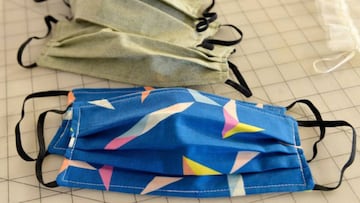How to make a face mask to help slow Covid-19 spread
Since the quarantine period started in the United States many people started panic buying and stockpiling essential products such as face masks.

The United States now has over half a million confirmed coronavirus cases and starting the month of May many states are starting to slowly reopen the economy and public schools. The White House said they are preparing to provide people with Covid-19 tests even if a person does not show the symptoms as they start to end their quarantine period.
Also President Donald Trump has said that ‘social distancing’ guidelines should remain active until further notice and people should wear face masks at all times when they are in public places. Some people have decided to make their own face mask because in the beginning there where a lot of panic buying and stockpiling were sold out in a short period of time.
2 ways to make a face mask at home
Learning how to make a face mask doesn't have to mean getting to grips with a complex pattern or dusting off your sewing machine. There are many different ways to make a homemade face mask, and here, we cover three of the ways outlined by the CDC (Centers for Disease Control and Prevention), adding in our own tips on how to make the most comfortable and easy to put together face mask.
The easiest method for making your own face mask involves using a bandana or a scarf. Note that if your bandana or scarf is too thin, hold it up to the light to see how much you can see through it, the less you can see, the better, then your face mask won't be as effective. Materials that are tightly woven and 100 percent cotton are best.
The CDC recommends folding your bandana in half, then folding it again twice, lengthways from both the top and the bottom. At this point, you can also add a square piece of coffee filter, paper towel or kitchen roll to your mask, which you can change. Then place your rubber bands or hair ties around your strip of material, and fold the material in towards the middle, tucking the ends into each other if possible.
If you have a T-shirt that you don't mind cutting up, then you can easily and quickly make a face mask from it. Note that you don't want to be using really old T-shirts if they have holes in them or are worn through. Ideally, your T-shirt should be 100 percent cotton and as opaque as possible.
To start, simply cut the bottom off your T-shirt. The height of the amount of material you need should be the length from the top of your nose to underneath your chin (around 7-8-inches of 17-20cm). It's best to cut bigger than you think you need so you can trim the excess later.
You then need to cut into your T-shirt – around 6-7-inches (15-17cm) – to make the ties for your face mask. Follow the video or diagram below to see how to do this. Next, cut your ties so that you can tie it around your head. Adjust until you get a snug fit around your nose and chin. If you like, you can add a coffee filter or paper towel to your face mask, and secure it with a safety pin.
There are various ways to make a cloth face mask, of varying difficulty. The simplest patterns require just two pieces of cloth and some elastic, or something that you will use as ties. If you want your DIY face mask to stand out, try using bright or patterned fabric.





